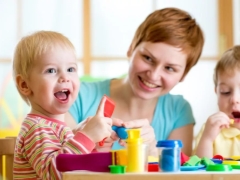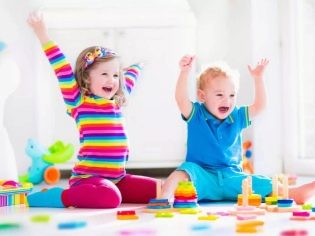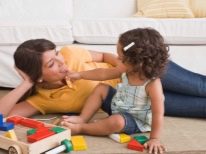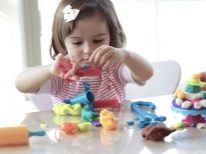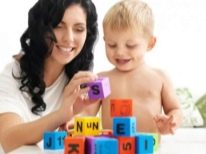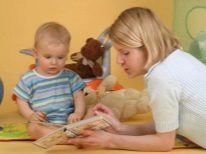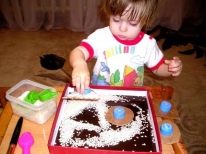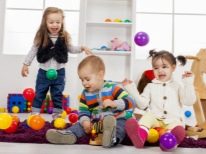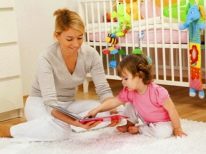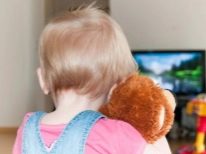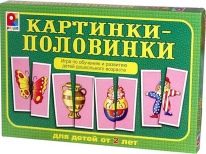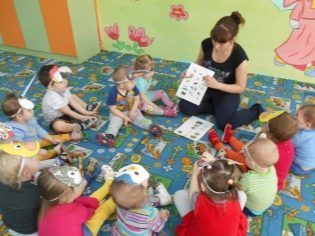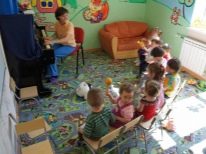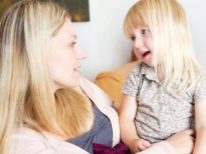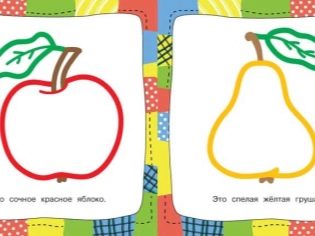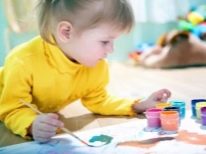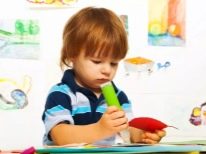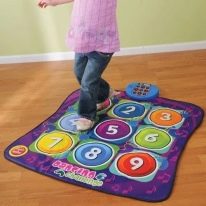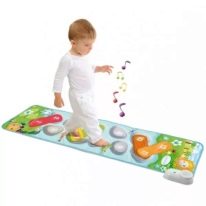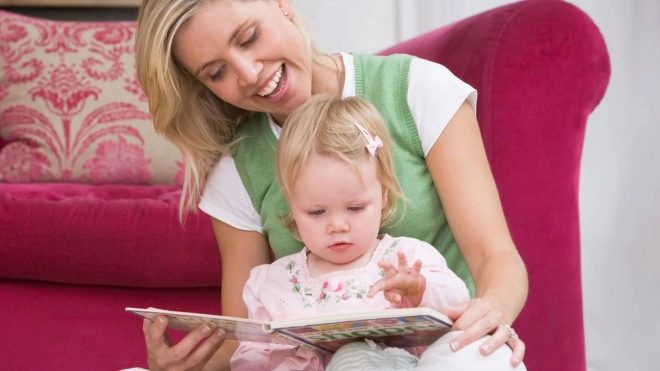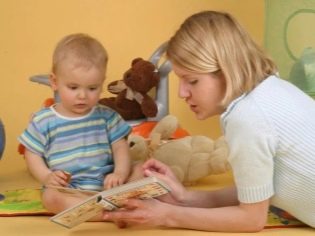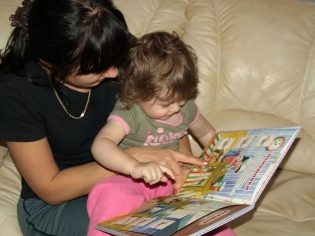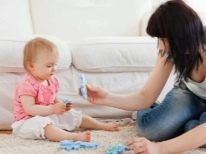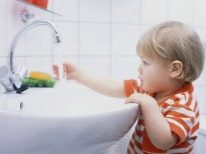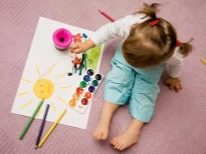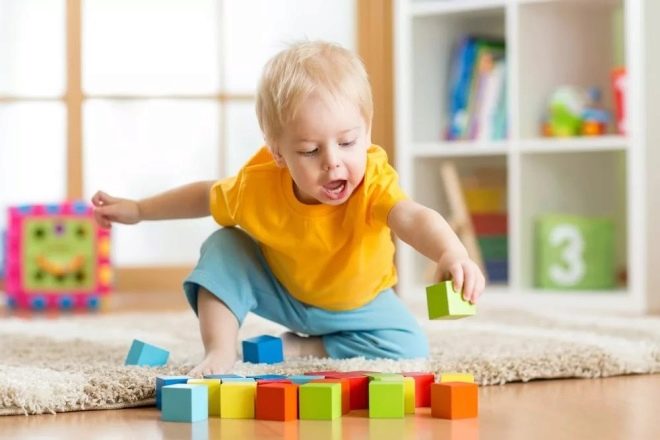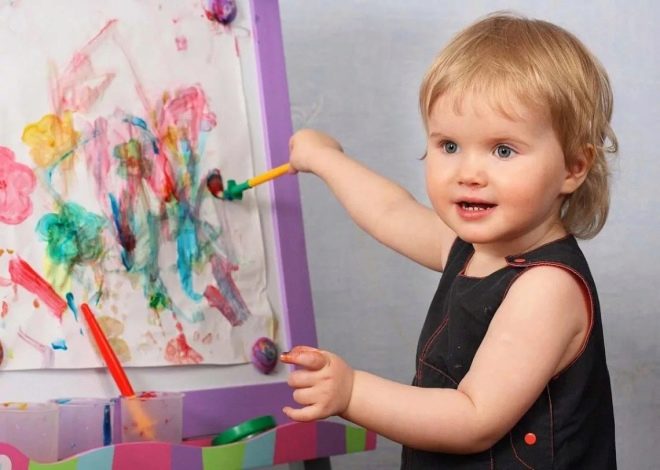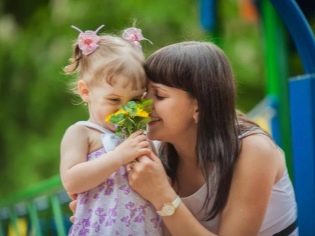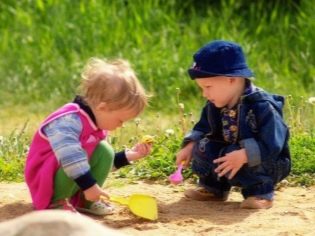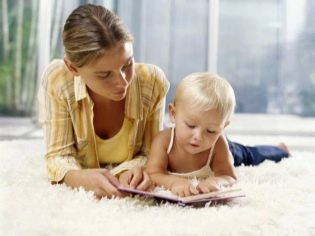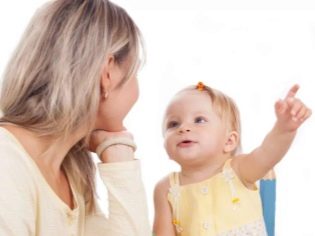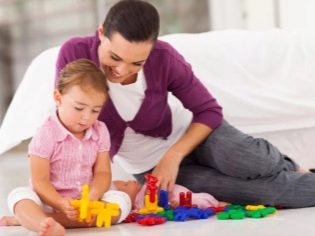Educational activities for children 2 years
Living in the environment of society, children are literally doomed to development, but if you let it run its course, the process can be very long or even go the wrong way. The modern world requires the child to quickly develop and assimilate a huge amount of information and skills, so it is simply necessary to direct it.
Many parents leave this task to tutors in nurseries and kindergartens, however, they themselves could take on part of the task. It is clear that the child will develop faster if you do it both in kindergarten and at home, and not only in kindergarten, so parents should pay more attention to the ways of development of their baby.
Development tasks at this age
It is possible to determine the development objectives, starting only from the existing skills and abilities. At two years old, the child is already radically different from the newborn, but at the same time, each baby is different, so it is impossible to guarantee the achievement of a certain level. In this case, you can select some common directions, where pedagogical efforts should be directed both to kindergarten teachers, and parents themselves:
- Speech A two-year-old child is probably already able to speak some individual words, but someone is limited by this, while others are even able to convey some simple thoughts, such as the desire to eat. In any case, the current level is completely insufficient to fully integrate into society or at least go to the first class, therefore it is very important to teach the child to speak - at least in order to understand it himself.
- General and fine motor skills. At the age of two, children can already walk and run independently, as well as hold any sufficiently light objects in their hands, and yet they have almost no dexterity. Their movements look uncertain, they are able to constantly drop things from the hands, and any task that requires high accuracy and accuracy will be impossible for them. Improving motor skills is necessary for greater comfort of the child, and for his safety.
- Attention. The consciousness of a two-year-old karapuz is absent-mindedly - usually he is not interested in the fact that he does not attract attention by itself. Nevertheless, the ability to concentrate is very useful both for studies and for many types of work in the distant future.
- Abstract thinking and fantasy. Imagine for a second that you are completely devoid of imagination - that is, you cannot even visually imagine a well-known subject if you do not see it at the moment. Would such a person have much? But for two-year-old children, this characteristic is in many respects relevant - more precisely, they simply do not have a large number of familiar subjects, they are just beginning to explore this world.
In the future, the good development of these qualities will allow to achieve a high level of ingenuity and the ability to invent something completely new.
- Creative. The successes of the child in the creative field allow him to assert himself, to increase his own self-esteem, and even find new friends.It does not have to become an outstanding master, because creativity can be not only a profession or the meaning of life, but also just a pleasant pastime. Even if you personally consider creativity to be a waste of time and effort, note that it develops well the same memory and motor skills.
- Social development. Excessive shyness in the modern world is a disadvantage, but inappropriate self-confidence will not be a plus either. The child must be able to behave in society, understand the generally accepted rules and not violate them, be polite and not insult other people. Already in two or three years it will give the result in the form of the first kindergarten friends, well, and in adulthood the ability to attract strangers to oneself can become truly invaluable.
Auxiliary materials
It is quite obvious that only ingenious parents can come up with a whole set of exercises for the development of a two-year-old child, so you have to rely on a number of supporting materials, which, fortunately, exist in a huge variety:
- First of all, books can help in the development of a child. Mostly such publications are designed for parents, because two-year-old children cannot read a priori; they can be described in detail the popular development programs, for example, Montessori methods, which professional educators and educational centers around the world have been using for more than a century.
If the book also contains pictures, it may still be of immediate interest to the child - some experts argue that it is possible at that age to begin teaching the child to count by showing him pictures with a digital designation of the number of objects on them.
- An alternative to books in our technological age can be programs that can now be found on the Internet or purchased on disk. They can more clearly show the tasks and exercises that would help the child achieve better success in their own development. In a sense, even ordinary cartoons with a fairy tale can perform such a function, although the pedagogical role, of course, differs in each case.
- Auxiliary materials can be issued in the form of a whole set of different tools, fully revealing a certain program. In particular, from the age of two years, the use of developing board games, which may include cards and chips, as well as books describing the pedagogical effect of typing, and a multimedia component in the form of a disk.
A computer, by the way, can become an excellent auxiliary tool not only due to the ability to play videos, but also as a way to run electronic development games.
- Creative exercises also able to bring tremendous benefits. The classic and familiar version is poems that are learned in kindergartens. They perfectly develop children's memory, and most importantly - make the child repeatedly pronounce the learned words, improving pronunciation; the same effect is given by children's songs. All this can be bought in the form of a collection book, or you can find it individually on the Internet.
- Coloring and crafts contribute, first of all, to improving the fine motor skills of the child - thanks to them, he will learn much better to use his fingers and perform any fine work. In addition, the implementation of such tasks is very conducive to the development of the imagination, which can make an outstanding engineer or a writer out of a baby.
- Dancing also develops excellent motor skills, but now it is rather large. They allow the child to gain confidence in their movements, and ideally even make them graceful and beautiful. Nowadays, manufacturers produce special dance matswhich stimulate the baby to move not chaotically, but in a strictly specified direction.
Child psychologists are well aware that the child is not yet aware of the usefulness of achieving the goals set, therefore, he will resist development attempts from the side unless he is interested. This can be done only by giving the process a playful form, so all the presented solutions look like games, but they certainly carry a deep developmental subtext.
It should be noted that none of the above mentioned means is perceived by children as a routine.
Development classes
Purposeful efforts to develop the child will give a much more significant result than spontaneously arising situations that require a certain self-development from the baby. Children look much more developed in those parents who are aware of their own responsibility for the development of the baby, and have thoroughly approached the study of relevant pedagogical methods. There are hundreds of ways to improve the basic skills of a two-year-old child., we briefly consider only the most popular, which should be in the arsenal of all young parents.
Speech
For the development of speech is very important to make the child speak regularly. Practice shows that children brought up at home are not very actively using speech, limited to minimal needs — ask for food, turn on a cartoon, and so on. Some are generally limited only to crying, and it’s not about full vocabulary expansion at all.
Usually the child’s conversational activity is stimulated with the help of learning nursery rhymes and songs. This is interesting to the kid thanks to the fabulousness of the plot, as well as due to the undisguised approval of adults admiring every new piece of work learned; quite specific reward for success can serve and sweets.
As a result, the child will at least speak more intelligibly, as a maximum - he will learn a few new words and will make more active use of speech for communication. In general, you can not invent anything, but just communicate more with the child by asking him various questions. Even if the answer is monosyllabic, it still contributes to the achievement of the desired result.
Attention
The development of attention is promoted by simple games that do not require any additional purchases at all and are available absolutely in any situation. The simplest example: go with the child to the window and ask him to find and show the green car. Or let him find some detail shown in the picture. You can simultaneously develop and associative thinking by asking the child to find not a specific object, but any objects that have a common quality — the same color, shape, or any other characteristic.
A game of this type can be bought - most likely, there will be cards of different colors, shapes and patterns, and the task of the little player will be to search for cards with certain qualities.
General and fine motor skills
For the development of general and fine motor skills are well suited various creative tasks. In particular, modeling clay and drawing, as well as crafts and puzzles are of great benefit for the development of fingers. At this age, the baby is hardly blind or draw something worthwhile attention, however, the meaning is not in creating a masterpiece, but in acquiring the confidence of movements, so even the banal kneading of a piece of plasticine will benefit.
Connecting the dots with lines to get a real picture will also be a good productive solution.
You can even just teach your child something useful, for example, wash your hands under the tap. For the development of large motor skills, any active physical exercises are well suited - both dances and games in the open air.
Abstract thinking
The concept of abstract thinking may seem too complicated for children as young as two years old, but at this stage it means a simple study of the properties of objects.The baby is still poorly oriented in distinguishing between soft and hard objects, their quantity, color, and so on.
To improve the understanding of all these things, a big bizybord - board with attached samples of various mechanisms and materials. At the same time, it is necessary to pronounce the names of certain characteristics to the baby, and then ask him to indicate only soft objects or only hard, or large, or cold, or wooden ones.
It is very important to teach the child to distinguish objects in form, and food - also in taste and smell. In addition, the baby is ready to distinguish between the same and different.
Creative development
Creative development will not give creative results yet, but it will contribute to the improvement of other useful skills. Creativity, whether music or drawing, develops a good memory, because the child has to keep in mind what he is trying to reproduce. It also generally stimulates thought processes and imagination. If creativity involves the active participation of hands (for example, drawing or modeling), then it also contributes to the development of fine motor skills.
Social development
Social development of the child is to teach him to behave in society. At the age of two the minimum tasks are set - to give the kid an idea of greeting, farewell, gratitude and politeness in general. Some psychologists recommend already at this stage to give the child to play such games, where there are winners and losers - so that he learns to play with dignity.
In general, communication skills in society are best developed in a wide circle of communication, Therefore, here parents are more likely to give a general direction, while the details are much better told in kindergarten, where children also have an excellent opportunity to consolidate what they have learned in practice.
Fantasy
The timely development of fantasy will greatly contribute to the overall acceleration of thinking and expanding horizons. Best of all, different role-playing games will do. - those where the child is supposedly in the place of someone else. To be honest, for the two years of age it is most likely still too difficult, but you can try to invite the kid to imagine himself in the place of a fairytale hero, if it is a boy, princess or doctor, if it is a girl.
For greater naturalness, you can buy in the store toy attributes of the child whose role the child tries to get into. Thanks to this, you can get a completely unexpected result: for example, children are massively afraid of doctors, but at the same time they love to play with children's medical kits, and according to the results of such games, the fear of doctors retreats!
Expand the range of concepts and get acquainted with the new
The world of a two-year-old child is predominantly limited to his apartment, in the best case - it is supplemented by a playground and a nearby park. This does not allow him to learn all the concepts necessary in life, even if they seem elementary to adults.
remember, that There is almost nothing that you would know completely independently, not from the words of other people, not from books and TV shows, that is, almost all the information about the world you received from someone, so now it's time to share it with the baby.
Show and explain to your child literally everything around. Tell, for what purposes each room and each piece of furniture in the house serves. Go to the store with your child and show him where all the delicious food he eats every day comes from. Take a ride with your child in a car or public transport, take a walk with him somewhere far from home and show something he has not seen before. Take the little one to the zoo or show the aquarium.
Tell us what a family is, how it is formed. Try to explain what mom and dad do, and not necessarily in the sense of the professions - you can even just by the example of cooking, washing dishes, cleaning the apartment.Tell us what professions there are and why they are needed. Teach your child the names of different parts of the body.
Try to make the child involved in the topic, try to conduct a mutually interesting conversation, otherwise the kid will forget everything.
Do not speak in abstractions, find an opportunity to visually show the children what you are talking about - not on the blue screen, otherwise they will perceive it later, but either in the real performance, or at least in a toy.
You should not expect the little listener to instantly get to the heart of the matter, you will probably have to repeatedly repeat to him what you have said before, but in any case he will memorize some new words, broaden his horizons, and eventually he will use all this knowledge to build a quite meaningful conversation.
Sample plan for the week
Parents, especially zealously suited to the development of their child, tend to make an exercise plan for the week, which is largely correct. This will help not to overload the baby, developing it evenly, without bias in the direction of any one quality, and also ensures that you fully ensure the development of the child. This should take into account the character and temperament of the baby, as well as his strengths and weaknesses.
In no case should the plan once drawn up by you or someone else be taken as a constant - follow the process carefully and evaluate the resultsto quickly adjust the schedule.
Directing the development of the child, do not drive him into too tight frames - sometimes a little one will want to play not what you offer, but something else, and he should also have such an opportunity.
When drawing up a plan, especially make sure that the load on different days is approximately the same in volume. Carefully select a variety of tasks - for example, knowing the world around you can and should be every day, but think up at least 5-7 different ways to do it, and do not start the circle again until you complete it.
Tips
There are a few simple tips, failure to comply with which can completely erase the expected positive effect of employment. Be sure to follow these rules:
- Knowledge is always absorbed better. if the student is interested in this, but they are not shoved into him by force. A two-year-old child is interested in learning only as a game, so find a way to interest him. If the child does not show interest in the game at all, at the moment or in principle, do not even think about forcing him - you will only make it worse.
- In fact, at this age, very little time is devoted to classes, because concentration of attention in a child is achieved for no more than a few minutes, after which the task must be changed. However do not customize the baby and do not perform the task for him - he must learn himself.
- The fact that such a small child does not have a task that seems elementary to you is normal, and scold him for that, as well as for not wanting to do, Absolutely forbidden, otherwise, he develops aversion to this occupation.
Success is quite another matter: it should definitely be commended, because it will be a good incentive for further achievements.
Interesting educational activities for children from 2 years, see the following video.
